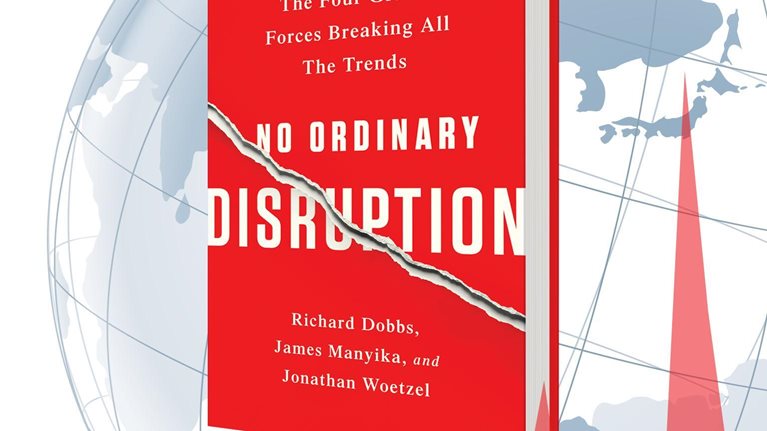Our intuition about the world of work needs to be reset. In the United States, labor-force participation is lower than at any time in the past three decades, and jobless economic recovery seems the new normal. More types of jobs are being automated, yet a shortage of skilled workers is looming worldwide, including in China, despite its huge pool of labor. Technology also makes it possible for employers to redesign and disaggregate work, and to reassign routine tasks to lower-skilled employees. In health care, for example, chronic disease management can be assigned to nurse practitioners rather than to physicians.
These and other changes are part of the larger disruptive forces which are fundamentally reshaping the global economy. In the labor market, some of these shifts are already evident—and the disruption they bring about will only get larger.
As a result of new technologies that automated work, and the ability to tap into the vast, newly engaged labor pools from the likes of China, Mexico and India, companies in advanced countries have been able to maintain or even increase productivity during times of growth as well as in downturns. In the two most recent US recessions, in 2001 and 2008-2009, reduced employment accounted for 98% of the decline in GDP, while productivity was barely affected.
The labor market, meanwhile, has steadily bifurcated, with menial low-wage jobs on one end and high-skill, high-wage careers on the other. Technology and competition from emerging markets have undermined those in the middle. Yet at the same time, there’s a skills gap: in the US, nearly two-thirds of companies report having positions for which they cannot find qualified applicants. The problem is especially acute in technology and health care.
Today we stand on the edge of another disruption. This one is again driven by technology. The technologies that automated millions of routine transaction and production jobs are now rapidly encroaching on higher-skilled-skill interaction jobs as well, that is to say, jobs which require personal interaction, problem solving and a range of critical-thinking skills. The information tools that helped improve productivity are now being used to disaggregate jobs into specialized tasks that can be scheduled down to the hour of a workweek with flexible labor and can increasingly be done remotely.
This process of disaggregation can give rise to new businesses and recruiting models. Websites and online talent-sourcing platforms are proliferating. In some cases, registered workers bid for simple work, such as a few hours of writing merchandising copy for websites. Other platforms offer the services of high-skill professionals or entire teams for projects such as software development.
Because technology changes jobs across sectors and geographies, employers around the world need to rethink whom, where, and how they recruit; how they can use technology to substitute for skills, not just personnel; and how they adapt their ways of working. The jobs the US economy has been creating in the past two years are very different in nature from the ones that were lost in the recession that followed the 2008 financial crisis. The labor market itself is now quite different. Technology is not only automating ever more jobs and increasing the skill gaps for the jobs that remain; it is changing the very nature of work and giving us ever less time to adapt.
As technological churn renders new skills outdated at an ever-faster pace, new skill gaps are showing up more often and in more places, increasingly decoupling labor supply and demand. By 2020, around the world, there is likely to be a shortage of approximately 40 million high- skilled workers and 45 million medium-skill workers. Against that will be a surplus of 95 million low-skilled workers. If the previous era was defined by millions of workers in China joining the global labor force, the next era will see skill gaps emerge even in China, as its number of young workers shrinks by nearly 50% between today and 2030 and the country falls short of 23 million high-skilled workers.
The contradictions and gaps in labor markets won’t resolve themselves. Governments, companies, and individuals will need to reset the way they think about labor markets, where to find workers, and the relationship between technology and work. They will have to focus on developing the skills and institutions needed to keep up with changing technologies. Companies will also need to explore new pools of talent and update their recruiting and training practices in order to respond to the labor challenge in an agile way.
In addition to looking abroad, companies could tap into growing pools of underused talent at home: older workers, women, and youth. In Japan, Toyota is recruiting retiring employees to work in part-time production roles. In the US, the e-commerce company Etsy, based in Brooklyn, in 2013 launched the “Craft Entrepreneurship” program, which helps chronically underemployed people turn their craft and manufacturing skills into supplemental income. On its site, some 88% of sellers are women, in a country where only 57% of women participate in the workforce.
The scale of technological change, the disruption in the way we work, and the mismatches between skills and jobs are all daunting challenges in the new global labor market. But they’re not insurmountable. At least since the introduction of the printing press, every time a new technology revolution has unleashed its powerful forces, humans have figured out a way to adapt, find new endeavors, and prosper. That, hopefully, is one long-term trend that is not being disrupted.
This article originally ran in Fortune.
